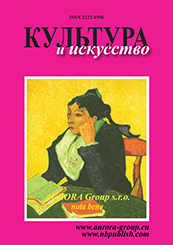Philosophy of culture
Reference:
Rozin, V.M. (2025). Models and projections of artistic communication. Culture and Art, 6, 1–12. https://doi.org/10.7256/2454-0625.2025.6.73530
Abstract:
The article proposes a new model of artistic communication. The author believes that the theory of communication is quite well developed. It builds a number of communication models, usually based on several approaches (the main ones are semiotic, informational, socio‒psychological, and engineering), but with an emphasis on a particular one. The author called the proposed one more model complex, it is built within the framework of the author's concept of "methodology with limited liability". The peculiarity of this concept is the analysis of thinking and creativity (in this case in art), mediated by cultural studies, semiotics, personality psychology. The complex model of artistic communication includes four projections: semiotic, artistic reality, socio-psychological and spiritual (speech). Depending on the type of work or artistic phenomenon being studied, as well as the specifics of the research task, certain projections will come to the fore, while the rest manifest themselves in the structure of the content. The concept of the U. Eco allows us to analyze artistic communication within the framework of a semiotic approach, but the author believes that if the task is to understand the essence of art and the features of artistic works, the semiotic approach is clearly insufficient. Four layered reconstructions of artistic communication are outlined: the first, the work as an artistic reality (the first projection); the second, the work as the realization of expressive means (semiotic projection); the third, the work as a way of socialization (the third projection); the fourth, the narrative (speech) of the artist as a condition of his contact with the audience (the fourth projection). At the same time, cases from Meir Shalev's novels "Two Bears Came Out of the Forest", "Fontanella" and "Esav", as well as Shalev's interview given to the magazine "Lehaim" are used as empirical material. The author argues that, given the semiotic and anthropological nature of art, it largely boils down to artistic communication.
Keywords:
culture, reconstruction, interpretation, understanding, art, composition, projections, approach, communication, model
Virtual reality
Reference:
Khotin, D.M. (2025). The specifics of VR cinema and the new cinematic language. Culture and Art, 6, 13–26. https://doi.org/10.7256/2454-0625.2025.6.74181
Abstract:
The subject of the research is one of the most advanced products of the modern film industry – VR cinema, created using virtual reality technologies. The article analyzes a new, special cinema language Virtual Reality Films, which has its own unique features. The relevance of the topic is due to the fact that VR cinema is an ultramodern phenomenon that has been developing rapidly in recent years and is arousing increasing interest among a wide audience of users. Films containing virtual reality are a related art form to classical cinema and animation. However, VR cinema and animation have a number of differences that manifest themselves at different levels. This article provides a structural analysis of VR cinema (both as a phenomenon in general and specific examples from the industry) in order to understand the specifics of creating a new cinema language of films with the inclusion of virtual reality. The paper examines the specific features of the new VR cinema language, analyzes cinema for virtual reality at several levels that are in close interaction with each other: technological, artistic, and user perception. Several films from the 2010s and 2020s are considered as examples of illustrating the principles of virtual cinema, and the evolution of their artistic language is analyzed. In the process of preparing this article, two key research methods were used. A theoretical method that includes conducting a structural analysis of the VR cinema genre, as well as key concepts, principles, technological and artistic techniques and effects related to this genre. The purpose of this analysis is to identify the unique specifics and characteristic features of the new cinema language inherent in VR films. A practical method that involves analyzing specific examples of films created in the Virtual Reality Films genre. The scientific novelty of the research consists in the generalization and systematization of fragmentary existing concepts about VR films, demonstrated in the considered works, and in the analysis of the evolution of the artistic language of virtual cinema, which it went through from 2010 to the 2020s. In the course of the research, the author became convinced that VR cinema has reached great heights in technical and technological aspects, in the field of maximum immersion of the viewer in virtual reality, in the field of managing the viewer's attention and perception. At the same time, in the age of accelerated scientific and technological progress, VR cinema is waiting for new discoveries in the field of technology. Thus, the article outlines the prospects for the further development of the VR cinema genre.
Keywords:
cinema language, cinematography, spherical space, interactivity, immersiveness, perception management, role of the viewer, animation, virtual reality technologies, VR cinema
Architecture and design
Reference:
Razvodova, I.A. (2025). Advertising banner in the exterior of the historical part of the urban environment: at the junction of art and marketing (Yelets' experience). Culture and Art, 6, 27–46. https://doi.org/10.7256/2454-0625.2025.6.72981
Abstract:
The paper is devoted to advertising images (banners) introduced into the historical urban environment. The concept of "banner blindness" is described, an analysis of scientific literature is made, revealing modern approaches to eliminating this problem, as well as the possibilities of increasing the purchasing power of citizens, which directly depends on the attractiveness of the environment. The issues of the influence of the environment on the mental health of a modern person are touched upon, especially in connection with his increasing immersion in virtual space. The article considers banners for the facades of historical architecture of the city of Yelets (Lipetsk region) on the pedestrian Mira Street created in 2022 within the framework of the adopted design code. The choice of a single stylistic solution for the entire studied section of the historical pedestrian street with a preserved ensemble of merchant architecture is substantiated. The method of systemic analysis of sources made it possible to determine the insufficient development of this topic in the scientific community. Using a field survey of a section of Mira Street, as well as a comparative analysis of building facades before and after applying the design code, it was found that banners have a harmonizing potential and can increase the attractiveness of even unrepaired buildings. The author of the article is the developer of the described banners, his practical experience can contribute to further study of remote graphic elements in the architectural environment. In modern documents devoted to the creation of a design code for the urban environment, there are no clear rules for creating banners, perhaps the experience of this study will help to fill some gaps in the regulation. The scientific novelty of this study lies primarily in its reliance on specific material in the environment of a real city, which allows you to clearly trace the success of the project. The preserved complex of merchant and noble architecture of the 19th century in the city of Yelets requires an integrated approach to the design of all remote elements; the surface area of advertising banners affects the appearance of the building façade; modern means allowed to create images adequate to the historical building, without conflicting with the style of historical architecture.
Keywords:
culture, advertising, architecture, Yelets, design-code, painting, design, art, style, banner
 This work is licensed under a Creative Commons Attribution-NonCommercial 4.0 International License.
This work is licensed under a Creative Commons Attribution-NonCommercial 4.0 International License.
 Eng
Eng












 © 1998 – 2025 Nota Bene. Publishing Technologies. NB-Media Ltd.
© 1998 – 2025 Nota Bene. Publishing Technologies. NB-Media Ltd.




